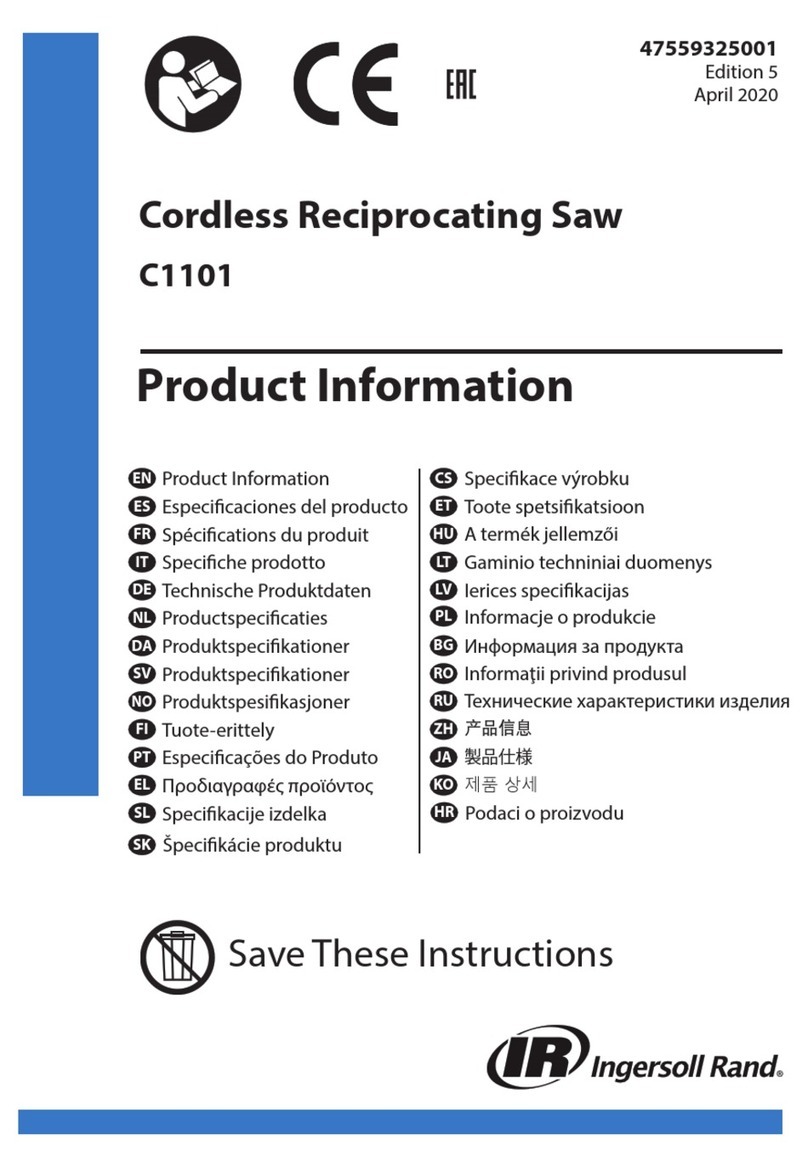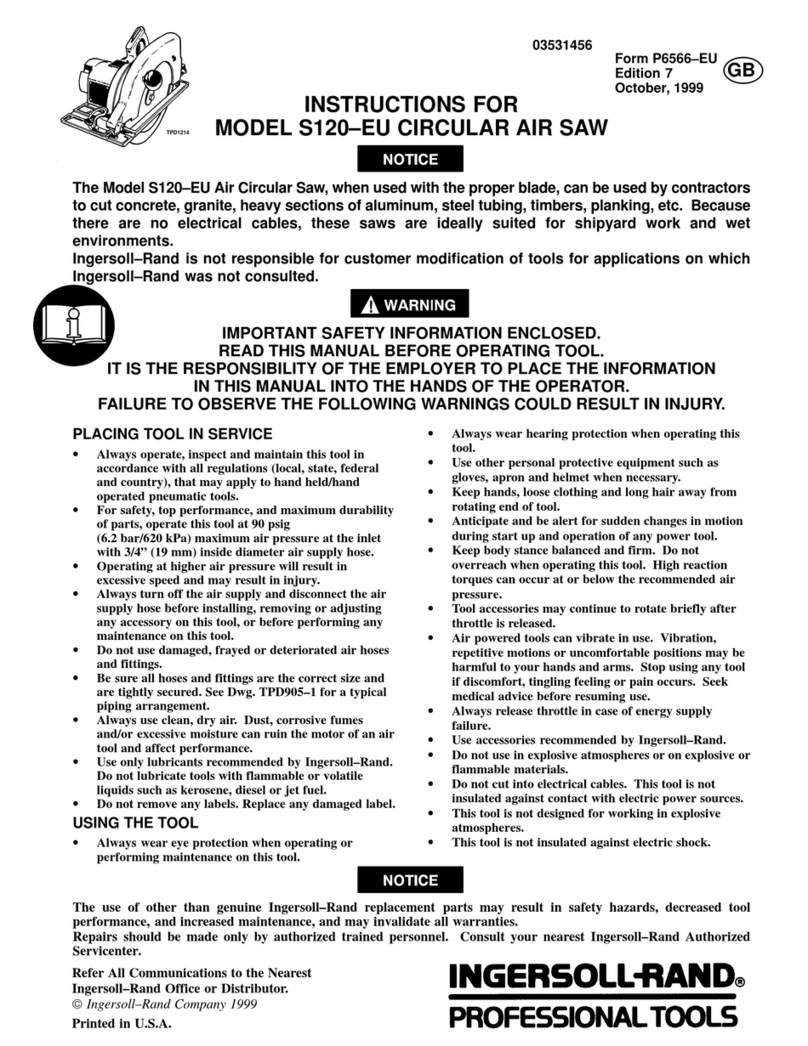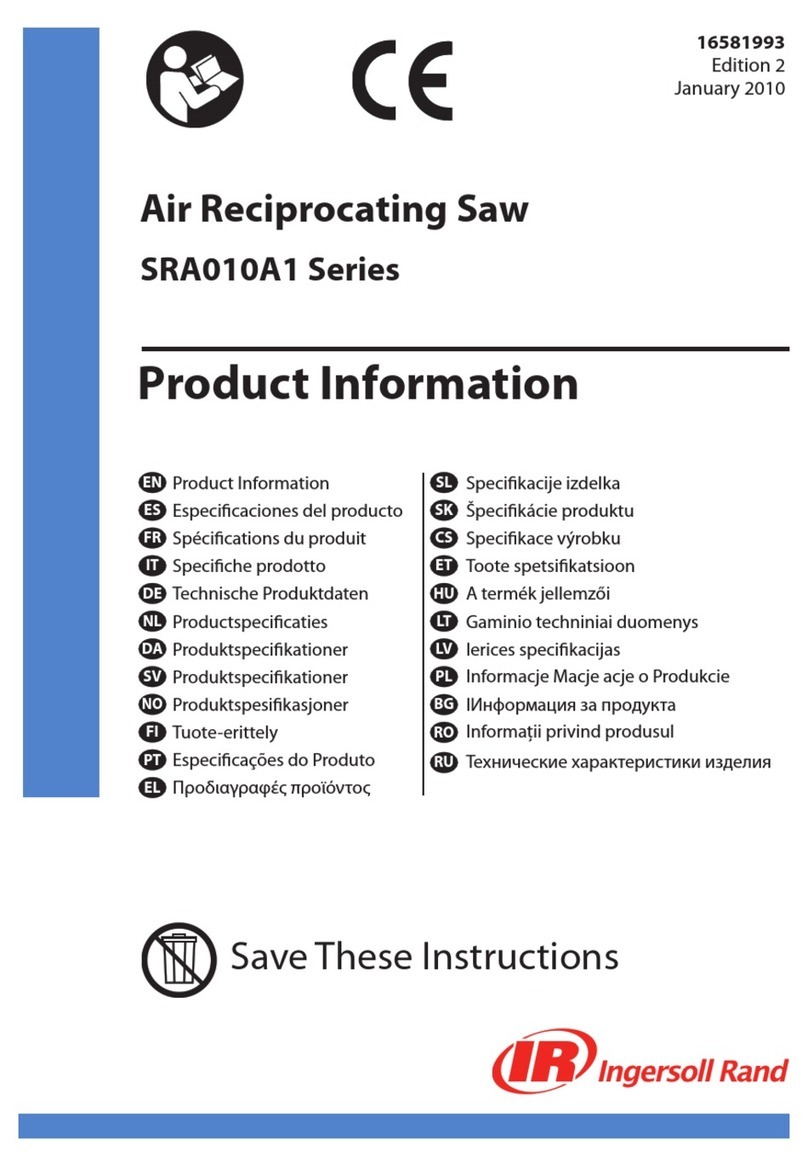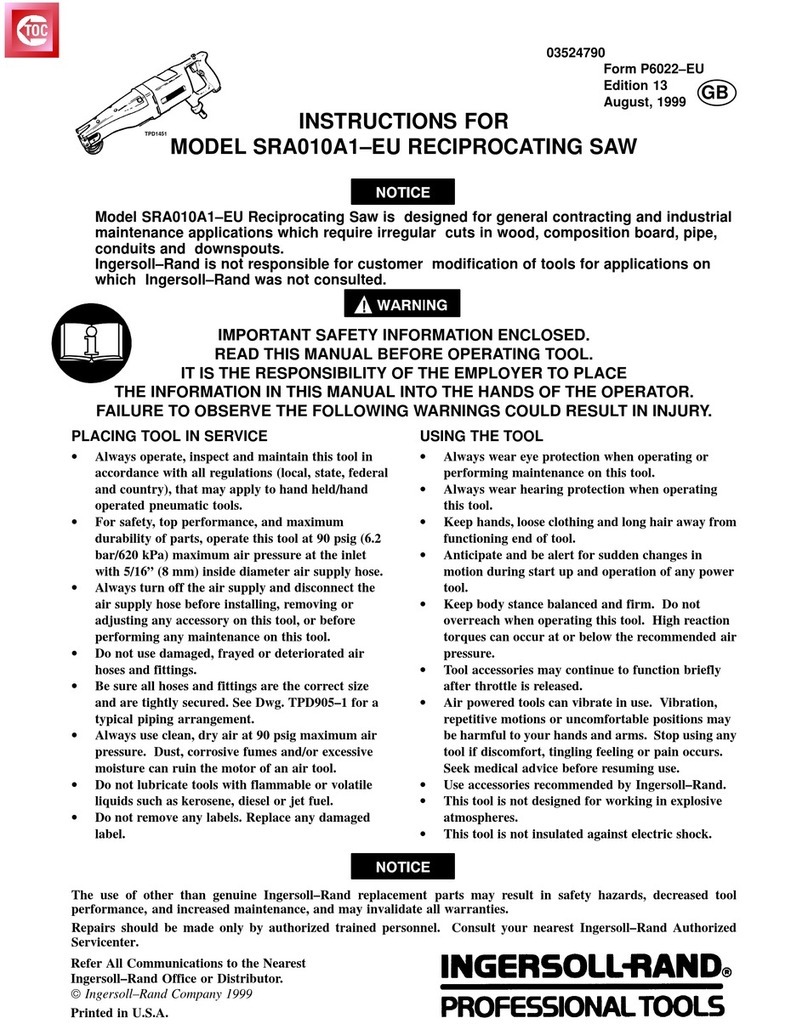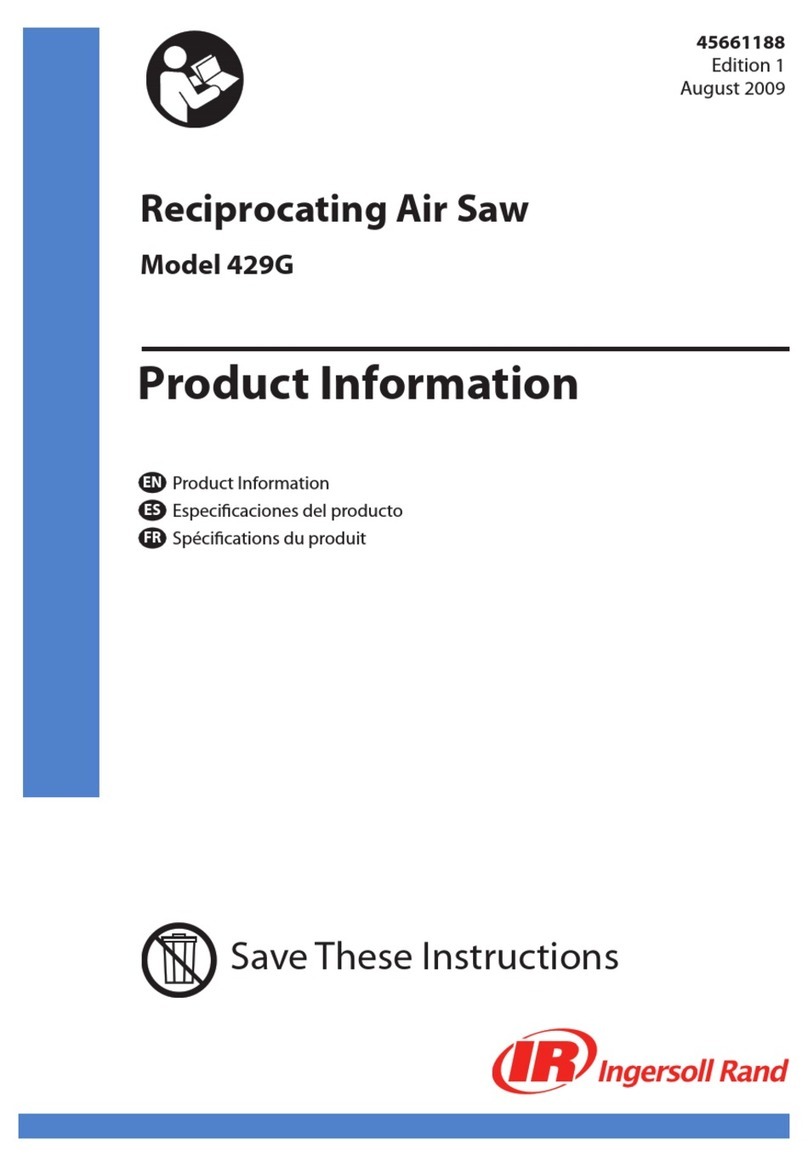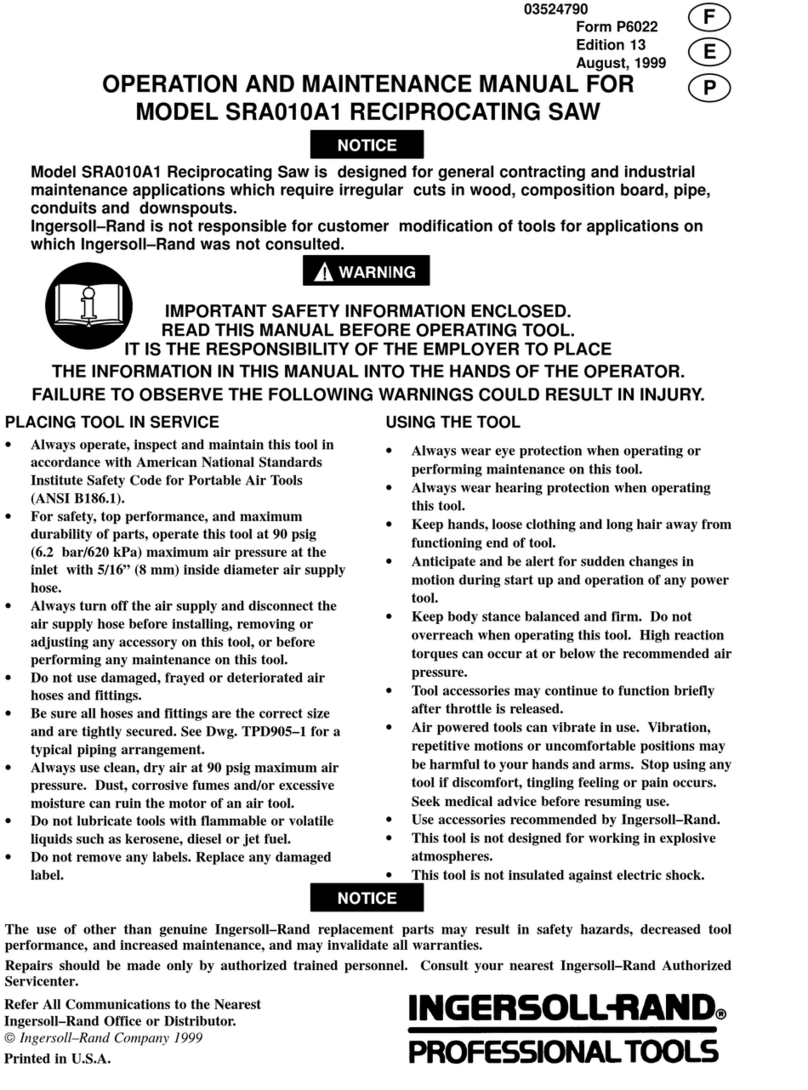
EN
TL-C5101-LIK_ed2 EN-2
• Disconnect the plug from the power source and/or remove the battery pack, if detachable, from the power tool before making any adjustments,
changing accessories, or storing the power tool. Such preventive safety measures reduce the risk of starting the tool accidentally.
• Store idle power tools out of the reach of children and do not allow persons unfamiliar with the power tool or these instructions to
operate the power tool. Tools are dangerous in the hands of untrained users.
• Maintain power tools and accessories. Check for misalignment or binding of moving parts, breakage of parts, and any other condition
that may aect the power tools operation. If damaged, have the power tool serviced before using. Many accidents are caused by poorly
maintained power tools.
• Keep cutting tools sharp and clean. Properly maintained tools with sharp cutting edges are less likely to bind and are easier to control. Keep
handles clean and dry to maintain control.
• Use the power tool, accessories and tool bits etc., in accordance with these instructions and in the manner intended for the particular type
of power tool, taking into account the working conditions and the work to be performed. Use of the power tool for operations dierent from
intended could result in a hazardous situation.
•Keep handles and grasping surfaces dry, clean and free from oil and grease. Slippery handles and grasping surfaces do not allow for safe
handling and control of the tool in unexpected situations.
•When wearing gloves always be sure that the gloves will not prevent the throttle mechanism from being released. Personal injury may result.
•Do not remove any labels. Replace any damaged label. Labels provide information required for safe use of the product.
Battery Tool Use and Care
• Recharge only with the charger specied by the manufacturer. A charger that is suitable for one type of battery pack may create a risk of re
when used with another battery pack.
• Use power tools only with specically designated battery pack. Use of any other battery pack may create a risk of injury and re.
• When battery pack is not in use, keep it away from other metal objects, like paper clips, coins, keys, nails, screws or other small metal
objects, that can make a connection from one terminal to another. Shorting the battery terminals together may cause burns or a re.
• Under abusive conditions, liquid may be ejected from the battery; avoid contact. If contact accidently occurs, ush with water. If liquid
contacts eyes, additionally seek medical help. Liquid ejected from the battery may cause irritation or burns.
•Do not use a battery pack or tool that is damaged or modied. Damaged or modied batteries may exhibit unpredictable behavior resulting
in re, explosion or risk of injury.
•Do not expose a battery pack or tool to re or excessive temperature. Exposure to re or temperature above 130°C (265°F) may cause explosion.
•Follow all charging instructions and do not charge the battery pack or tool outside the temperature range specied in the instructions.
Charging improperly or at temperatures outside the specied range may damage the battery and increase the risk of re.
• Ensure switch is in the o position before inserting battery pack. Inserting the battery pack into power tool with the switch on invites
accidents.
• Disconnect battery pack from tool or place the switch in a locked o position before making any adjustments or changing accessories.
Such preventive safety measures reduce the risk of starting the tool accidentally.
•Electric tools will overheat if they remain on when the tool motor is severely loaded, stalled or otherwise kept from rotating. Turn tool
o when this occurs. Continuing to power tool in this condition may result in heat, smoke or re with injury or property damage.
•Disconnect battery pack from tool before storing tool or placing in a tool box or bag. Accidental starting while storing or transporting
may cause several hazardous conditions including an overheated tool. Uncontrolled tool operation may cause various hazards including
heat, smoke or re.
•Do not block the housing cooling air holes as this may cause overheating of the tool. Use of the tool in this condition may result in heat,
smoke or re with injury or property damage.
•The tool may overheat during continuous use or other severe duty cycles. Immediately stop operation and let the tool cool if any part of
the tool becomes too hot to touch or if there is any indication of smoke from the motor. Continuing to use the tool under these conditions
will cause tool damage and may result in injury or property damage from heat or re.
•Immediately stop use and replace any battery that gets excessively warm in use or oers very short usage times. Typically these batteries
have a high number of charge/discharge cycles or may be old or damaged. Continuing to use an impaired battery may result in injury or property
damage from heat, re or explosion.
• Do not modify this tool, safety devices, or accessories. Unauthorized modications may result in electric shock, re or personal injury.
• Use only accessories that are recommended by Ingersoll Rand for your model. Accessories that may be suitable for one tool, may become
hazardous when used on another tool.
• When wearing gloves always be sure that the gloves will not prevent the throttle mechanism from being released. Personal injury may
result.
• Do not remove any labels. Replace any damaged label. Labels provide information required for safe use of the product.
Service
• Have your power tool serviced by qualied repair person using only identical replacement parts. This will make sure that the safety of the
power tool is maintained.
•Never service damaged battery packs. Service of battery packs should only be performed by the manufacturer or authorized service providers.
• When servicing a tool, use only genuine Ingersoll Rand replacement parts and follow all Maintenance Instructions. Use of unauthorized
parts or failure to follow Maintenance Instructions may create a risk of electric shock or injury.
• Do not dispose of batteries in re, incinerate or heat above 100° C (212° F). Batteries present a risk of re or chemical burn if mistreated.
• Responsibly recycle or dispose of batteries in accordance with all applicable standards and regulations (local, state, country, federal,
etc.). Improper disposal may endanger the environment.
WARNING
Product Specic Safety Rules
• Hold tool by insulating gripping surfaces when performing an operation where the cutting tool may contact hidden wiring. Contact with
a“live” wire will also make exposed metal parts of the tool“live”and shock the operator.
• Use clamps or other practical way to secure and support the workpiece to a stable platform. Holding the work by hand or against your
body is unstable and may lead to loss of control.
• Do not use dull or damaged blades.
• Blades can bind or break while cutting. Maintain balance and do not overreach or cut overhead. Wear eye protection and other appropriate
Personal Protective Equipment.
• Do not touch saw blade and blade clamp (chuck or holder) which may be hot after cutting.
